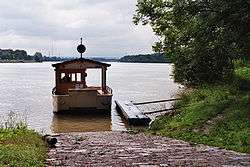Mauthausen
| Mauthausen | ||
|---|---|---|
 | ||
| ||
 Mauthausen Location within Austria | ||
| Coordinates: 48°14′31″N 14°31′01″E / 48.24194°N 14.51694°ECoordinates: 48°14′31″N 14°31′01″E / 48.24194°N 14.51694°E | ||
| Country | Austria | |
| State | Upper Austria | |
| District | Perg | |
| Government | ||
| • Mayor | Thomas Punkenhofer (SPÖ) | |
| Area | ||
| • Total | 14.03 km2 (5.42 sq mi) | |
| Elevation | 265 m (869 ft) | |
| Population (14 June 2016)[1] | ||
| • Total | 4,849 | |
| • Density | 350/km2 (900/sq mi) | |
| Time zone | CET (UTC+1) | |
| • Summer (DST) | CEST (UTC+2) | |
| Postal code | 4894 | |
| Area code | 07238 | |
| Vehicle registration | PE | |
| Website | www.mauthausen.at | |
Mauthausen is a small market town in the Austrian state of Upper Austria. It is located at about 20 kilometres east of the city of Linz.
During the Second World War, it became the site of the Mauthausen-Gusen concentration camp complex.
History
The area of Mauthausen has been settled for many millennia, as shown by archaeological discoveries dating back to the Neolithic age. During the time of the Roman Empire, it was at the crossroads of two trade routes.
At the end of the 10th century it became a toll (Maut in German) station for ships, and the name "Muthusen" for the settlement is first mentioned in 1007
During the First World War, a prisoner of war camp existed to the east of Mauthausen.[2] Italians, Serbs and Russians (at times 40,000 men) soldiers were imprisoned there, around 10,000 of whom died in the camp, mostly Italians, actually half. A war cemetery exists in their memory. The prison had especially guards from Hungary and Romania who were known for their barbaric tortures of the soldiers.
During the Second World War, from 1938 to 1945, one of the first massive concentration camp complexes in Nazi Germany was set up to the west of the town. In early 1940, a large number of Poles were transferred to the Mauthausen-Gusen concentration camp where an estimated 30,000 Poles perished. Inmates were subjected to barbaric conditions, the most infamous of which was being forced to carry heavy stone blocks up 186 steps from the camp quarry. The steps became known as the "Stairway to Death".
Mauthausen experienced flooding from the River Danube in 1954 and 2002.
Population
| Historical population | ||
|---|---|---|
| Year | Pop. | ±% |
| 1869 | 2,485 | — |
| 1880 | 2,808 | +13.0% |
| 1890 | 3,196 | +13.8% |
| 1900 | 3,354 | +4.9% |
| 1910 | 3,545 | +5.7% |
| 1923 | 3,048 | −14.0% |
| 1934 | 3,186 | +4.5% |
| 1939 | 4,378 | +37.4% |
| 1951 | 3,562 | −18.6% |
| 1961 | 3,836 | +7.7% |
| 1971 | 4,432 | +15.5% |
| 1981 | 4,346 | −1.9% |
| 1991 | 4,403 | +1.3% |
| 2001 | 4,845 | +10.0% |
| 2009 | 4,873 | +0.6% |
| 2015 | 4,894 | +0.4% |
Tourism
Places of interest include:
- Mauthausen-Gusen concentration camp
- 15th century church
- Picturesque old town
- 16th century Pragstein Castle
References
- ↑ Statistik Austria - Bevölkerung zu Jahresbeginn 2002-2016 nach Gemeinden, Erstellt am 14.06.2016 (Last accessed 13.12.2016) for Mauthausen.
- ↑ Mauthausen is listed among Austro-Hungarian POW camps in Beiblatt Nr.13 zum Verordnungsblatt für das k.u.k. Heer from spring 1916, see English language translation.
| Wikimedia Commons has media related to Mauthausen. |
